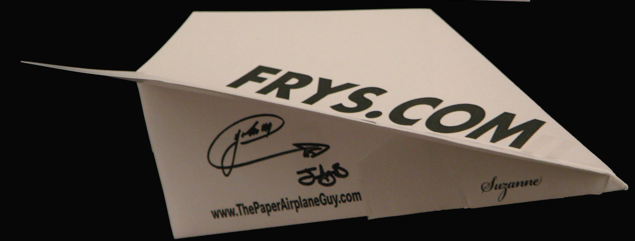How to Make the World’s Best Paper Airplane

Take a normal piece of paper, fold it following a few basic instructions, and you’ll end up with a paper airplane. With only a little bit of practice, even the most amateur paper aviator can propel the resulting creation five to ten feet forward, and maybe even get a few seconds of glide time out of it. It’s cheap, easy, and reusable (well, for a few dozen flights, at least).
John Collins, though, wants to do better.
Collins, by day, was a producer at a San Francisco-area television station. But he’s best known for his hobby, which has earned him the nickname (and the corresponding website URL) The Paper Airplane Guy. In 2008 or 2009, Collins — who was already interested in paper airplanes and the art of origami — became fascinated with building the world’s farthest-flying paper airplane. He began studying aerodynamics and related topics for three years as he tested design after design.
The result of Collins’ obsession: Suzanne. That’s what he named his most successful paper airplane design, seen below.

Suzanne, Collins was sure, could break the record — 207 feet, four inches — but not with Collins’ arm powering it forward. He needed someone with more arm strength and better throwing mechanics, so he began recruiting potential partners. One of his colleagues at the TV station he worked at knew a guy named Joe Ayoob. Ayoob, just a few years earlier, was the starting quarterback for the University of California, Berkeley and had played a few years of pro football in the Arena league. Ayoob was the archetypical paper airplane launcher.
In February 2012, team Collins-Ayoob made their attempt at the record at an airplane hangar (for real airplanes) at McClellan Air Force Base outside Sacramento, California. Ayoob made ten official throws (and, he told ESPN, probably another 40 unofficial throws that day), and on throw number four Suzanne flew 226 feet, 10 inches — a record by nearly twenty feet. Here’s a video of the world-record throw.
Why does Suzanne work so well? The wide-winged rectangular planes that virtually anyone can make are, like gliders — it doesn’t matter much how hard you throw them, as they float slowly forward (hopefully) regardless. To get more distance, most competitive plane throwers use tightly-designed, triangular planes which, Collins told Mental Floss, are “basically sticks with fins. Those planes operate as darts, flying through the air as if a ballistic missile. Suzanne is a combination of the two, and as Collins notes, the first of its kind. (If you want more details on the technical specs, Collins gave a pretty in-depth interview to Popular Mechanics, which you can find here.)
You can try and make one yourself if you’d like, too. Here’s a video introducing the build order (but it is incomplete) and Collins has a book out, available here, which details every step. A few words or warning, though: you’ll need some tools (most of which you can find around the house) and, to really get the distance down, a quarterback to throw it for you.
Bonus Fact: Could a paper airplane go from the International Space Station back to Earth? Maybe. Researchers in the Department of Aeronautics and Astronautics at the University of Tokyo are working on a prototype, which, according to New Scientist, shows promise — it can withstand temperatures of 200 °C, and may be able to survive re-entry. But, as the New Scientist further explains, the paper airplane would be too tiny to be picked up on radar. Figuring out whether it made the trip successfully (and, if it did, where it landed) would be nearly impossible.
From the Archives: Crease and Desist: When football fans threw too many paper airplanes, one man threatened legal action. The football team in question wrote probably the best response letter you’ll ever read.
Take the Quiz: Name the countries that contribute to the International Space Station.
Related: “The New World Champion Paper Airplane Book” by John Collins. This is the book which tells you how to make the Suzanne and others. 4.3 stars on 50 reviews.
